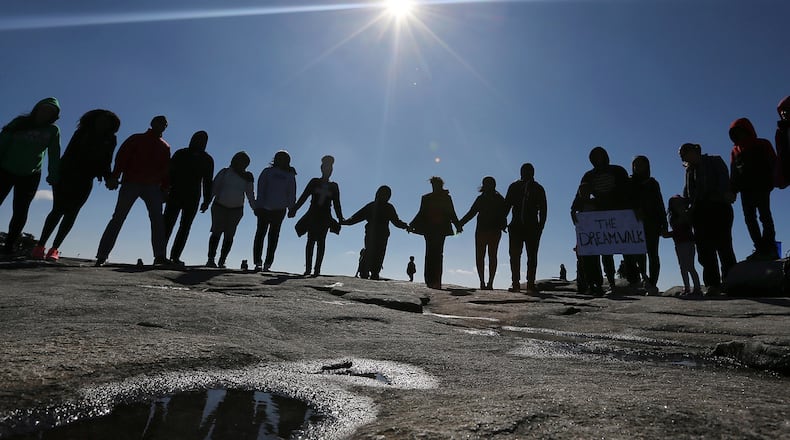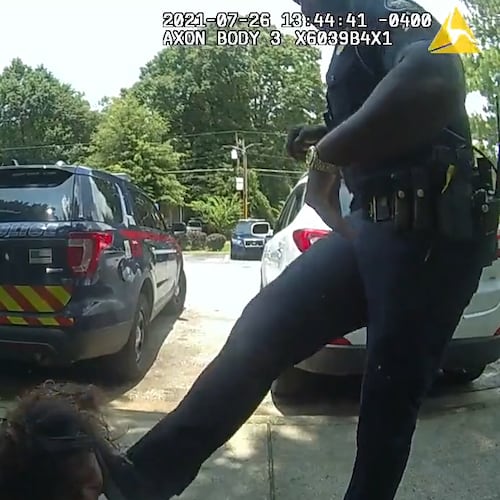Editor's note: When this story first ran in October 2015, there seemed to be real momentum for some kind of tribute to Dr. King at Stone Mountain Park. However, at this time the idea remains just an idea.
At 65, Mark Pozner climbs Stone Mountain at least four days a week. And at least four days a week, he walks or jogs past the row of battle flags at Confederate Hall on his way to the top of the rock.
Pozner has immersed himself in both the stark beauty and the dark history of Stone Mountain: the summit affords a view of Atlanta like no other, and it also provided a stage for the 1915 resurgence of the Ku Klux Klan. That fact, and the three Confederate heroes carved into the mountain’s flank, led Dr. Martin Luther King to invoke the rock during his 1963 speech on the National Mall: “Let freedom ring from the Stone Mountain of Georgia,” he intoned.
“The fact that the KKK was born here in 1915 shocked the hell out of me,” said Pozner, who has lived in Tucker for 22 years. “Then I thought of King’s words in ‘I Have a Dream.’ He picked it because he knew the Ku Klux Klan had been there. I had been thinking for a long time that something should be done on Stone Mountain to acknowledge that.”
On June 16, Pozner walked into a Stone Mountain Memorial Association board meeting and, in his three minutes of allotted time, told the board it should honor King by placing a plaque on the mountain featuring the “let freedom ring” quote.
“I honestly didn’t expect much,” Pozner said. “The response that I got was, ‘We will think about it.’”
Pozner had no idea that Bill Stephens, the CEO of the memorial association, was indeed thinking about it. It had been on his mind for at least two years.
On the day before he would appear before the association board, a white gunman walked into a black church in Charleston and massacred nine worshippers.
‘Let freedom ring’ with Liberty Bell replica
In an exclusive report last Sunday, The Atlanta Journal-Constitution described how state authorities, including Gov. Nathan Deal, had agreed to erect a monument to King featuring the words “Let freedom ring from Stone Mountain of Georgia.”
It will be more than the plaque that Pozner suggested, but an elevated tower — featuring a replica of the Liberty Bell to symbolically and physically “let freedom ring.”
Preliminary plans also include a permanent exhibit focusing on black soldiers in the Civil War.
“This increasingly seemed like a logical addition to the park, as well as a book end to the stories from the Civil War through the Civil Rights movement here in Georgia,” Stephens said. “Additionally, the Freedom Bell and new museum exhibit would offer two new reasons to come and experience Georgia’s already most visited destination.”
Although no price tag has been attached to the project, it will not be financed by taxpayer money. Instead, it would be financed with park revenue — chiefly parking and entrance fees.
Since the story broke, Stephens has been fielding phone calls from all over the country, while ducking in and out of meetings.
Andrew Young delivers a surprise
And while the idea of a King memorial on the mountain was initially greeted with enthusiasm, several groups – from the predictable (Sons of Confederate Veterans), to the surprising (the NAACP and SCLC), have come out strongly against the plan.
Both sides, for their own reasons, believe that King should not be associated with anything to do with the Confederacy.
Andrew Young walked into that fray on Friday with yet another surprise. The former Atlanta mayor and one-time confidant of King said the monument is a great idea.
“I think it is a wonderful symbolism to have a Freedom Bell on Stone Mountain that would honor Dr. King,” Young said. “It is not only a good idea. It is a necessary idea for this nation to pull together.”
Young’s remarks must have been welcome for Stephens.
“We have been more than a bit surprised by the volume and diversity of the opposition to both efforts,” Stephens said. “Our goal was to make Stone Mountain even more welcoming and inclusive to all visitors. The current climate might effectively have a negative impact on our existing four million guests, and we certainly do not want that.”
A 100-year-old image problem
For all of its beauty, Stone Mountain has had an image problem for the last century. It was there, mere yards from where the King memorial would go, that the Ku Klux Klan was reborn in 1915.
The family that previously owned Stone Mountain, which they used as a granite quarry, gave the Klan exclusive permission to meet there, and when they sold the property to the state in the 1950s, it was designated as a memorial to the Confederacy.
“Along with putting up something for Dr. King, I think the Confederate flags should also come down,” Pozner said. “That flag represents nothing other than racism for most Americans. But I would leave the carvings. Those were some bad guys, but that was history.”
The idea of putting a “let freedom ring” monument on Stone Mountain may go back as far as two years. On Aug. 28, 2013, the 50th anniversary of the March on Washington and King’s “I Have a Dream” speech, Sen. Emanuel Jones (D-Decatur) led several hundred people up Stone Mountain.
National organizers of the anniversary celebration asked that bells ring simultaneously at every spot that King spoke of – from the prodigious hilltops of New Hampshire to the heightening Alleghenies of Pennsylvania to the snow-capped Rockies of Colorado.
‘That was a great day’
Jones, who at the time was the head of Georgia’s Legislative Black Caucus and the newly minted chair of Deal’s Martin Luther King Jr. Advisory Council, was one of several speakers that day.
At the same time that King’s three surviving children were in Washington ringing a bell on the steps of the Lincoln Memorial, bells rang out atop Stone Mountain.
“That was a great day,” Jones said this week. “And it was the catalyst for what we are seeing now.”
Although he wasn’t on the program, Stephens was also on top of the mountain that day, standing quietly in the back, leaning against a building. Thinking.
Fast forward to the Charleston Massacre and the resulting attacks on symbols of the Confederacy, and Stone Mountain became a likely and convenient target.
Supporters of the Confederate flag used Stone Mountain as a rallying point. Some of those on the other side saw Stone Mountain as a relic of a defeated and racist cause and demanded that it remove its flags and even sandblast Jefferson Davis, Robert E. Lee and Stonewall Jackson off its side.
Stephens said Thursday that there have been no serious discussions about removing Confederate symbols – they are codified in state law — and that Stone Mountain was about “additions and not subtractions at the park.”
‘From the Civil War through the Civil Rights movement'
“Following this summer’s attention to and calls for removal of the Confederate flag and all related symbology, our staff and leadership began a series of discussions and internal meetings about ways to make Stone Mountain Park even more welcoming and inclusive,” Stephens said.
Stephens said the first idea was the creation of the museum exhibit to honor black soldiers who fought for both the Union and the Confederate armies during the Civil War.
“Out of those discussions a theme began to emerge of a view of the modern American South which spanned the time frame from the Civil War through the Civil Rights movement,” Stephens said. “The Freedom Bell concept emerged from these discussions and was then shared with our board leadership, the governor’s office and others.”
In July, Atlanta Journal-Constitution columnist Jim Galloway wrote a Political Insider column about the relocation of the Cyclorama to the Atlanta History Center. He concluded the column by suggesting that King’s “I Have a Dream” quote about Stone Mountain should be inscribed somewhere atop the mountain.
“This too was an indication,” Stephens said, “at least to us, that perhaps we were on the right path.”
Michael Thurmond, the former state labor commissioner and superintendent of DeKalb County schools, said that while he is optimistic about the project – especially the museum – he said he knows of very little black participation in any of the planning.
“We have to open the process to be more inclusive,” said Thurmond, who is also a Georgia historian. He wasn’t involved in any of the planning. “We still have time for that. We still have a long way to go on this.”
‘I’m glad they’re doing something’
Stephens hopes to have the monument in place by next summer. No physical plans have been unveiled, other than the concept of the bell.
“I am glad they’re doing something,” Pozner said. “But I would like it to have been more specifically focused on Dr. King himself. The idea of a bell is generic. I want something that directly credits Dr. King, like a statue.”
“Clearly there is no position or addition which is likely to appeal to or appease those with strong opinions on either side of these issues,” Stephens said, adding that the new exhibits will only enhance the park’s overall experience. “This was simply the right thing to do…broaden and expand the park’s historic and memorial offerings to be more inclusive.”
Early Friday morning, as he does most days, Pozner got up, drove five miles down the road from home and made his trek up Stone Mountain. Although his suggestion was noted in the minutes of the memorial association in June, he didn’t receive any credit when the news broke last week.
He is fine with that. He suggested that the monument may have been proposed “to divert attention away from eliminating the flag or sandblasting the carvings.”
“This is a quarter of what should be done, but it is something,” Pozner said of the monument. “Because the KKK was reborn on Stone Mountain in 1915, there is no more important place in America that the changes brought about by King should be recognized than on top of Stone Mountain.”
About the Author
The Latest
Featured


